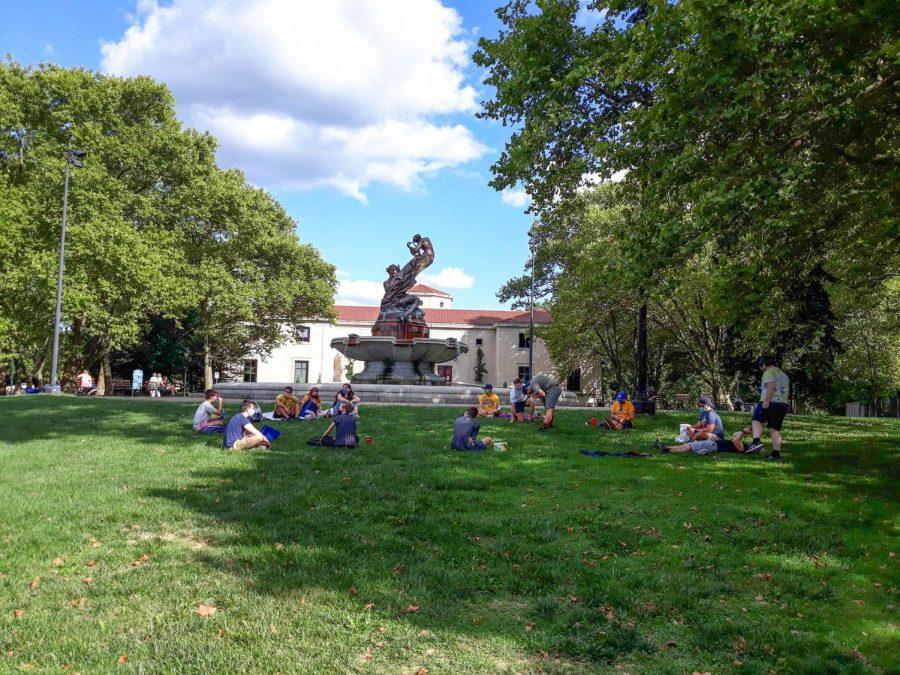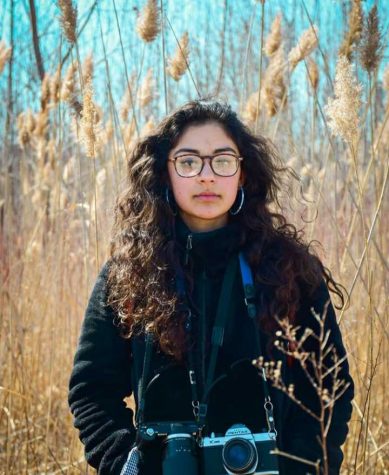Opinion | COVID-19 provides a much-needed push outdoors for Americans
Dalia Maeroff | Staff Photographer
Students gather on the lawn outside of the Frick Fine Arts building.
September 8, 2020
College students are returning to campus after a socially starved summer, having not seen many of their friends since March. A simple walk around campus on a sunny day at any point during the last month or so and one activity dominates the landscape — people are picnicking. Around the rest of Pittsburgh’s residential family neighborhoods, kids on bikes seem to be everywhere you look. Frick and Schenley parks are crowded with people spending time outside.
Coronavirus spreads easiest through the three C’s — closed spaces, crowded spaces and close contact. Unfortunately, these directly impact what college students love to do most — go to concerts, clubs and parties in damp and cramped South O basements — all indoor activities, and all off-limits in times of COVID-19.
So, students are pushed outside. Students are sitting in Pittsburgh’s variety of green spaces, both on campus and off, studying together, eating together and catching up on their day-to-day lives on picnic blankets. The coffee break in Redhawk or Starbucks with friends between classes no longer exists. The “Hey, I haven’t seen you in forever! Let’s get coffee sometime this week and catch up!” is a thing of the past. Now, it’s weekly picnics and picnic study sessions to catch up with your friends. Socially distant hikes, walks, bike rides and picnics are now dominating the social landscape of Gen Z — a generation that was previously criticized by older generations for lack of time spent outdoors.
That criticism isn’t necessarily untrue. Gen Z has been dubbed the “indoor generation.” Gen Z kids only spend about four to seven minutes a day in unstructured play outdoors, and over seven hours a day in front of some sort of screen. Time spent with friends is easily done indoors, even without seeing those friends in-person, through multiplayer video games, FaceTime, Discord servers and the like. The beginnings of the pandemic only reinforced this, with the youth seemingly trapped inside. But as restrictions have loosened and students are headed back to school and college campuses, it seems that cabin fever has gotten to them, and they’re spending much more time socializing outside. COVID-19 is the impetus for a cultural shift that has been long-awaited in American society — a shift to an outdoor culture. By getting outside, the younger generation is contributing to what soon will be a healthier and happier society.
The problem of indoor living isn’t limited to just Gen Z. Americans just about lead the world in time spent indoors, in general, spend a whopping 90% of their life indoors. Older generations may have not become so involved in multiplayer video games, but they certainly are involved with their televisions. Americans on average spend about three hours a day in front of their TVs. About a quarter of Americans spend 21 to 24 hours indoors every day. This has been a downward trend for decades, as our interest in outdoor recreation peaked in the 1980s. Italians and Czechs spend the least amount of time indoors among the countries studied for Velux concerning indoor air quality, with just about 5% of people saying that they spend 21 to 24 hours indoors every day.
People in America now are pushing for outdoor spaces and outdoor recreational replacements to what they would normally spend their time doing indoors. Social lives, yoga classes, even classrooms have all been moved outdoors. But that is not enough. We need to collectively push for and make our own spaces outdoors in which we can safely spend time with other people, socially distanced in an outdoor setting. These changes shouldn’t only last for the duration of the pandemic — they should last from now on.
The pandemic is the push that America needs to bring that 25% of people spending the majority of their lives indoors down. 43% of Americans ages 13 and up said that they were planning on spending more time on outdoor activities such as hiking, visiting parks and camping because of COVID-19 restrictions. The younger the person, the more likely they were to say that they would be spending more time outside, with nearly half of Gen Z and millennials saying that they would be venturing outdoors more often due to COVID-19.
The draw of spending time in nature is not surprising from a cognitive standpoint, especially considering the amount of stress put onto people right now. Time spent in nature has long been studied, and research has shown that it restores cognitive ability, calms stress and anxiety and can even help with mild depression. Access to sunlight also has its necessary physiological benefits, like a healthier sleep schedule, lower blood pressure and a surplus of vitamin D, of which insufficient levels are associated with COVID-19 cases. During these stressful and lonely times, more and more people are looking to relax in nature, in what could be a mass cultural shift in younger generations especially, to get outside more often and for longer periods of time.
During this difficult time, COVID-19 is the push that America needs to get off our couches and to get outside. Coronavirus is going to be a defining force for the culture of this generation and hence future generations. They will remember a time in which they couldn’t leave their houses and dorms to go to parties or out clubbing, but they could go on a socially distanced picnic and spend time in nature. This pandemic has taken a physiological and emotional toll on everyone, no matter who they are, but it has become the inevitable catalyst that Americans needed to finally center their lives outdoors again.
Dalia Maeroff writes primarily about issues of psychology, education, culture and environmentalism. Write to her at [email protected].




